Lactose Intolerance
Lactose is the natural sugar in milk. A person with lactose intolerance lacks enough of the enzyme, lactase, to digest this sugar.
Signs & Symptoms
-
•Nausea.
-
•Cramps.
-
•Bloating.
-
•Gas.
-
•Diarrhea.
These symptoms start about 30 minutes to 2 hours after you eat or drink foods with lactose.












